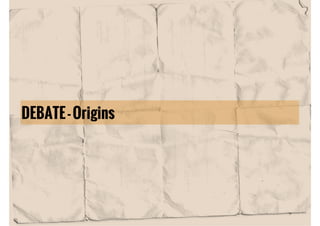
Debate intro:how to
- 2. ORDER OF DEBATE There are three debaters per side. Everyone gives one speech. This is the order of the speeches: First proposition constructive – 5 minutes This speaker makes a case for the motion for debate, providing a proof of the topic with three or four major points. First opposition constructive – 5 minutes This speaker makes several arguments against the proposition team’s case and refutes the proposition’s major points. Second proposition constructive – 5 minutes This speaker should rebuild and extend upon the proposition’s case. This means that this speaker must extend and amplify the original proposition points and refute the opposition’s major arguments against the case.
- 3. ORDER OF DEBATE Second opposition constructive – 5 minutes This speaker amplifies the opposition arguments against the case, providing new information about why the opposition team should win the debate. This speaker should answer the proposition’s answers to the opposition team’s original arguments. Opposition rebuttal – 3 minutes This speaker must put the debate together and explain why, given all of the arguments in the debate, the opposition team should still win the debate. Should finalize refutation of the proposition’s major points. Proposition rebuttal – 3 minutes This speaker should summarize the issues in the debate and explain why, even with the opposition’s arguments, the proposition teams should win the debate. Should refute the opposition’s major points.
- 4. MAKING BETTER ARGUMENTS The three essential parts of an argument can easily be remembered by using the abbreviation ARE. A stands for Assertion. This is a claim about the world, or a simple statement. R stands for Reasoning. Adding reasoning is essential to making arguments. The reasoning part of an argument is the “because” part of the argument. E stands for Evidence. Evidence provides proof of your reasoning. The most common type of evidence is an example.
- 6. REFUTATION
- 7. REFUTATION
- 8. REFUTATION
- 9. REFUTATION
- 10. REFUTATION
- 11. REFUTATION
- 12. POINTS OF INFORMATION Points of information may be a statement or a question. They can only be attempted during the middle three minutes of each constructive speech. They may not be more than 15 seconds long. The speaker must recognize you to make your point. If the speaker does not recognize you, you must sit down. When you draw the judge and the opposing team’s attention to your arguments, even when your team does not have the floor, the judge views you as an active and assertive participant in the debate.
- 13. POINTS OF INFORMATION It is seen as bad etiquette if your team constantly jumps up for POIs immediately after the speaker denies your point. It is a good rule to either wait 15 seconds after a speaker denies a point or wait until the speaker concludes his or her thought before you try again. Make your statement (whether it be an argument, example, or evidence) clear and concise. Answering POIs is a skill that every debater must learn. If the POI is an engaging argument or an attempt to rebut your arguments, you should attack these with arguments. Refer to other areas of your speech, state evidence that makes the POI a moot point, or create new arguments that respond to the POI.
- 14. POINTS OF INFORMATION HOW TO ANSWER ETIQUETTE • Be bold and concise. • Be respectful to the speaker • Use POIs to your advantage: to advance more • Rise calmly and quietly arguments and take away arguments from the • Wait patiently for a response other side. from the speaker • Do not let the POI distract you or get you off topic. • Make sure your POI does not • If a POI is not clear or does not matter in the exceed 15 seconds debate, say that. PLANNING STRATEGY • Anticipate opposing arguments • Make your POIs witty and insightful • A POI can be a new argument, an insightful reference to an old argument, or evidence that makes the speaker’s points invalid
- 15. NOTE TAKING Students and judges must take notes during debates. You will do so using a flow sheet. It tracks ideas and their development over time. The flow sheet to visually represent the debate and organize their speeches. HELP FOR USING YOUR FLOW SHEET 1. Write down as much as possible as the speaker talks. 2. Use abbreviations so you don’t get too behind. 3. Connect arguments with each other using lines, arrows, and circles. 4. Take notes on all speeches so you can help your partners and make effective points of information.